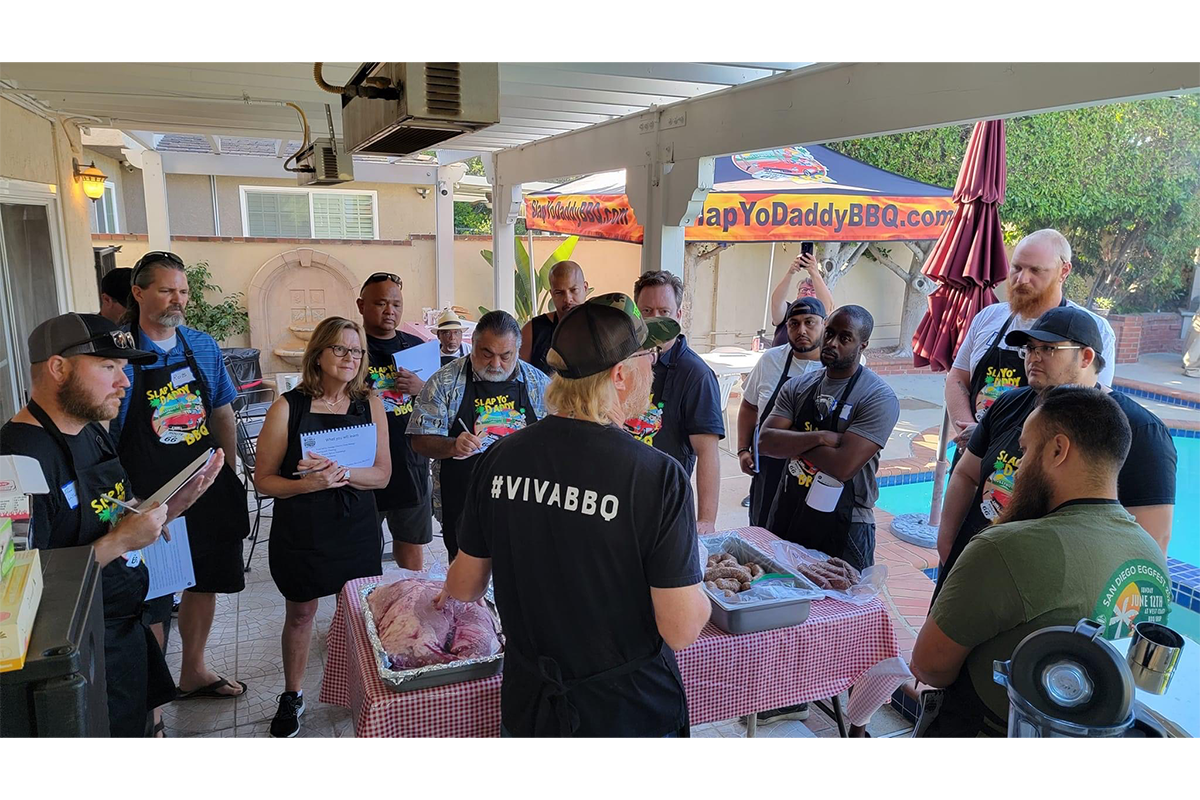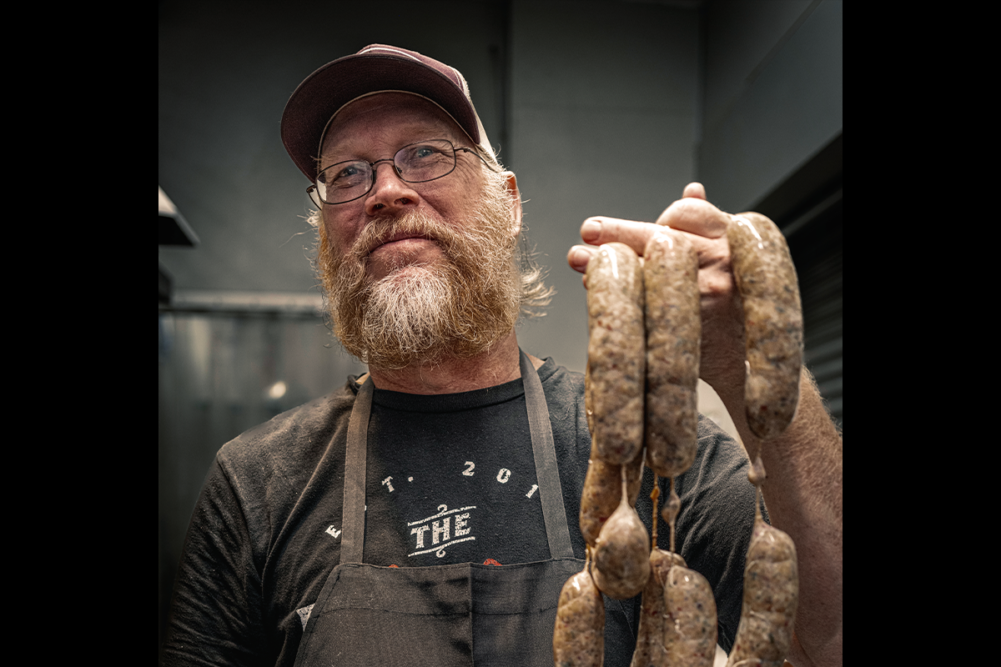Bill Dumas is very philosophical about how the sausage is made. He has refined his artisanal method and techniques over the years and respects the history and craft of making sausage. In fact, the native Texan is known to many in the culinary world and especially in the barbecue restaurant segment as the “Sausage Sensei.” He is a well-studied student of his craft and now works in a region considered the hotbed for Texas barbecue restaurants as the sausage maker for Brotherton’s Black Iron Barbecue in Pflugerville, about 18 miles north of Austin.
In his current role, Dumas works alongside Brotherton family members and longtime pitmasters who give him the freedom to create outside-the-box, seasonal sausage creations that are offered on the menu in addition to the mainstays. In many ways, he is like an artist, creating paintings or sculptures in his own studio.
Learning the ropes
Growing up in a small town in North Texas, Dumas spent a lot of his childhood with his grandfather, a salesman in the apparel industry who became known for his prowess as a pitmaster, specializing in cooking chickens and making homemade barbecue sauce. Dumas shadowed him and learned about cooking barbecue during those years and especially when that side business took off after his grandfather retired from his day job and became deeply ensconced in the Texas barbecue culture.
As a young man, Dumas went on to serve in the military as a US Marine and later would work as an over-the-road truck driver for years as well as working as an HVAC technician and several other odd jobs. In 2012, following the death of his son, he decided to immerse himself in the world of barbecue and apply his time and effort to master a craft he’d always been passionate about.
About 10 years ago, Dumas went to work at Smokey Denmark’s Sausage Co., leading the Austin-based iconic eatery’s foray into the food truck business. He said it was there that he honed his skills as a sausage maker working in a federally inspected sausage processing facility that distributed products all over North America. The food truck venture was successful beyond expectations, he said, and it opened his eyes to the endless possibilities that could be realized with sausage products. Experimenting with the possibilities spilled over into what Smokey Denmark’s sold and took it to the next level of success, Dumas said.
“Not just pushing the products that were made within the production facility themselves, for which we certainly did daily,” he said, “but we also started pushing the envelope of what sausage could be.”
He said once he learned the fundamental components and food science behind the creation of a general meat emulsion as a culinary medium, developing new flavor profiles and products was simplified. He learned how to blend recipes for various dishes into sausage emulsion and manipulate that meaty medium into a new product.
“In that regard, the emulsion is simply your blank canvas, and you can push the boundaries of what this humble food item is; you can start creating all kinds of crazy things,” he said.
“Sausage production operates within the same spectrum as artisanal baking,” he said. “Specific meat-to-fat ratios must be precise, salt ratios must be precise, and how you handle the product or don’t handle the product also plays into that same paradigm. The sky’s the limit once you realize that.”
 Dumas spends almost every weekend teaching his barbecue techniques and sharing his sausage secrets with paying attendees at all skill levels, from backyard cooks to restaurant operators. (Source: Bill Dumas)
Dumas spends almost every weekend teaching his barbecue techniques and sharing his sausage secrets with paying attendees at all skill levels, from backyard cooks to restaurant operators. (Source: Bill Dumas)Creativity rules
For Dumas, the standard flavors he makes consistently for the restaurant typically include traditional Texas beef sausage, brisket boudin and jalapeño and cheese sausage. But his creativity and innovative culinary style really shines with some of his novelty creations that are specials featured on the menu, which have included unique creations like: peach cobbler sausage; Louisiana crawfish boil sausage; mac and cheese sausage; pimento cheese sausage; and Reuben sandwich sausage. In years past he has also experimented with game meats, including zebra and python used as the main protein. His production process starts on Tuesday during a typical week and the smoked and cured sausage products are ready to sell on Saturday. Volumes vary from 700 lbs to 1,200 lbs per week depending on any special features that are planned for the menu and the amount of business expected in a given week.
While the sky is the limit for the variety of sausage flavors Dumas can create, he is limited in the volume he can produce. He’s had discussions about producing his products commercially with potential processing partners in Texas, but so far, none are able or willing to adhere to his non-negotiable techniques and proven production practices.
“I would love to put some stuff out there on the market to the wider public, but the challenge is trying to find that right partnership to adhere to some of my policies and the way I do things process wise versus, what a normal commercial [processor] might do,” he said.
Dumas said his method for producing product is a three-day process, whether that is to make 3 lbs or 3,000 lbs, which isn’t feasible for most traditional sausage processing plants.
“I’m not sure that my process or my headspace or the way that I do things would be applicable in a commercial application,” he said. “If there’s someone out there that can help me do it, I’m all ears.”
He said his creative creations are the result of his playing with visual and textural elements.
“We’re making the composed dish and manipulating the ingredients of the composed dish to where they interplay with the emulsion, but they don’t break the emulsion and they don’t break the bind. And then you get those elements – visual, textural. That’s what I do, and that’s part of the challenge. From an artisanal standpoint, you can do that but in a commercial application, I haven’t seen anybody do that.”
A place in history
Dumas has a thorough understanding of the history of Texas dating back to it being under Spanish Colonial rule in the 16th century and the subsequent settlement of the territory by European immigrants, including settlers from Germany, Austria and Czechoslovakia through the 19th century. He said the diverse groups of settlers over hundreds of years brought with them their food cultures and adapted them to the climate and ingredients available in Central Texas as well as their methods of food preservation in an era that pre-dated refrigeration. These influences are still evident in the products served in what Dumas refers to as market-style barbecue that is prevalent in the region today.
“If we stop and think about that, and we think about what wurst and sausage is in relationship to these people that settled Central Texas, then we quickly discover how this is an integral part of Texas cultural food history,” Dumas said.
And for barbecue purists, like Dumas and his circle of colleagues in the Texas barbecue industry, a requirement to establish an eatery’s street cred is that they make their own sausage, in house, and a barometer for its reputation is based on the quality of the sausage it produces.
Many of his special menu additions are based on a holiday dish, like the Thanksgiving dinner sausage, which was featured on the “Today Show” several years ago. More recently, to honor John Brotherton, a longtime friend and owner of Brotherton’s who died unexpectedly in January, Dumas created a sausage based on one of his friend’s favorite barbecue dishes.
“Just in honor of him, I made an Alabama white sauce chicken sausage. So, every single element of the composed dish of the Alabama white sauce chicken was inside there; we’re talking the mayo, the horseradish, so the customer got the explosion of flavor from the white sauce chicken along with big chunks of the chicken suspended in the emulsion.”
On the drawing board and the next outside-the-box creation coming from Dumas is banana pudding sausage, using banana emulsion powder and adding visual and textural elements by flambéing like a bananas foster dish, complete with rum flavoring and brown sugar suspended in the emulsion along with liqueur-soaked vanilla wafers and incorporate them into the mix.
While Dumas has spent much of the last decade working with restaurants to develop their sausage programs, on most weekends he teaches sausage making to students at all skill levels at his restaurant and he gets plenty of requests to travel and do on-site teaching of his craft or cater meals for large groups at special events all over the United States and beyond, including in Australia and Brazil.
Looking ahead, Dumas said he has been approached for a proposed book deal, which he plans to pursue in 2024 and his sausage-making classes are as popular as ever. Meanwhile he hopes to continue making his brand of craft sausage and creating memorable eating experiences for diners and food enthusiasts.
His goal is to make food that is comparable to how art is created and perceived.
“Art is about making people stop in their tracks, think and reconsider. So, if I can continue to make people stop and reconsider their food, that’s a really good thing and I want to do that.”



